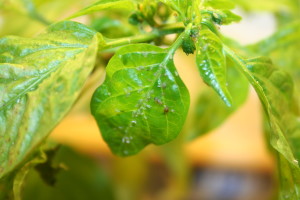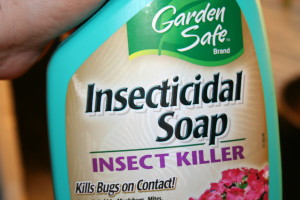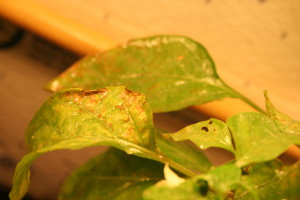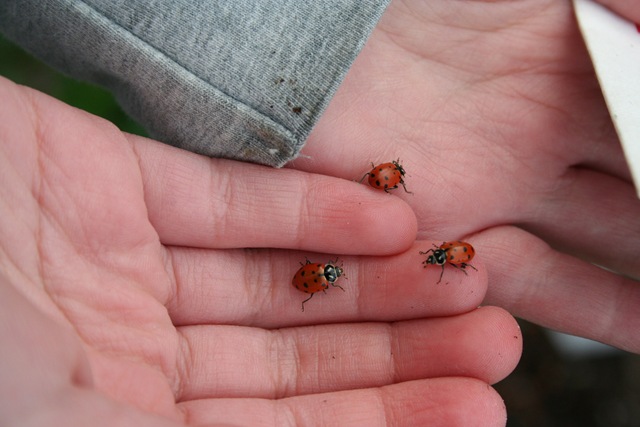Getting rid of aphids on pepper plants
14.9 years ago aphids, brown spots, ladybugs, peppers
It can be difficult getting rid of aphids on plants in your garden. Fortunately you can get rid of those aphids with materials you have in your kitchen.
First of all I am a little embarrassed that I let the infestation get this bad before noticing. I unfortunately set the grow box to have the sunrise at 1:00am and the lights always were off by the time I got home. Though the cause is not as important as how to get rid of them.
If this plant was outside my local lady bug population would have kept these buggers in check though they seemed to thrive without the vicious predators. For an outdoor plant a quick high pressure spray of water on the the leaves (as well as underside of leaves) would take care of the problem. Though this does not kill the aphids, they will starve to death before they make it anywhere to do any more damage.
This has not been my first battle with aphids, so fortunately I had some insecticidal soap on hand. I sprayed the entire plant from the top and bottom. I removed the major yellowing leaves and did another quick spray. Now if you don’t have any insecticidal soap, or just want to save $5 on buying a bottle here are a couple of proven recipes:
Simple Aphid Killer Spray
- 1 tsp dishwashing soap
- Fill 32 oz spray bottle with water
Directions:
Shake and spray liberally on tops and bottom of leaves ensuring aphids are covered completely.
Complex Aphid Killer Spray
- 1.5 tablespoon baking soda
- 1 tablespoon Murphy’s Oil Soap
- 1 tablespoon Vegetable Oil
- 1 tablespoon Vinegar
- 1 gallon water
Directions:
Pour into spray bottle and spray liberally on tops and bottom of leaves ensuring aphids are covered completely.
Extra Spicy Aphid Killer Spray
- 3 hot peppers chopped finely
- 1 quart of water
Directions:
Mix peppers with water and let seep overnight. Strain and pour into spray bottle and spray liberally on tops and bottom of leaves ensuring aphids are covered completely. WARNING: You care not to get this spray in your eyes.
US Department of Agriculture Mix
- 2 tsp dishwashing soap
- 1 cup of vegetable oil
- Fill 32 oz spray bottle with water
Directions:
Shake and spray liberally on tops and bottom of leaves every 9-10 days, ensuring aphids are covered completely.
If none of these solutions work, squish those buggers with your fingers being sure to include a sinister laugh while doing it. Which even if you are squeamish, this is what you will see if you let them have their way.
Tags: grow lights, growbox, outdoor plants, pepper plants, vegetables
3rd Annual Ladybug release
15 years ago aphids, kids, ladybugs
In case you missed the first and second annual lady bug release, you can follow those posts. We have never had a serious aphid or spider mite problem and I like to feel our annual release of lady bugs is the reason why. Either way, great entertainment for the girls for a couple hours for a $6.00 bag of lady bugs.
Lady bugs sometimes naturally choose to wander from the location where you release them and may just take residence in your neighbors yard, so I have thought about releasing them in my neighbors yard so they will end up in mine. Fortunately there are a few tricks to help entice your lady bugs from leaving your garden.
Give them a nap. Before you release them put them in your refrigerator for at least a couple hours. This will make them go asleep (dormant) until you are ready to release them. This way when you bring them outside in their sleepy stupor they may be more inclined to check out your garden before heading over your neighbors.
Feed them. After watering your garden before releasing them spray the ground with some sugar water. This will entice them to feast on that while waiting for a the aphids and spider mites to show up.
Choose the right time. Put your lady bugs out as the sun is falling and ensure that they are shaded from sun when releasing. This will prevent them from hiding from the hot sun and possibly finding a new place to make home.
Encourage your neighbors to have their own lady bug releases. One of our friends and neighbors had a great time with their girls releasing lady bugs last year and fortunately they are close enough that we may be sharing some bugs from both of our releases.
In the past I have had good results with the releases maybe seeing 30-40 lady bugs still crawling around on my plants the next day. This year had great results with hundreds of lady bugs in my aphid killing army.
Tags: cheap, outdoor plants, vegetables
Releasing ladybugs in your garden
16.2 years ago aphids, kids, ladybugs
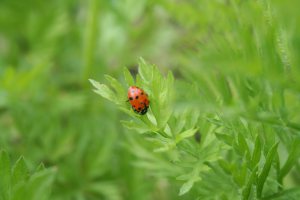
When we started my garden at my our current house my daughters and I noticed we didn’t have any ladybugs roaming around the leaves. Now I would like to think that aphids and mites feared me so much to dare to step foot in my garden, but the reality is I live in a newer neighborhood with vegetation in its early stages and with the lush forest around me it is hard to compete.
If the ladybugs will not come to your garden your only choice is bring them there yourself. I did this by purchasing some ladybugs at our local home and garden store which ours starts carrying them a little after the local last frost date. Unfortunately, I took my daughters with me when I bought a bag of 1000 lady bugs for $5.00 so no every time we go to Home Depot they need to check to see if the ladybugs are there today, guess this will be a yearly tradition. If you can’t find them locally you can always purchase live ladybugs online.
Why would I want these bugs in my garden? Well other my girls get a lot of joy searching in our garden for them they are also an awesome beneficial insect which each one can eat up to 5000 aphids/mites in their lifetime. When you decide to release them be sure to follow the directions on the package and do so at night so they don’t all fly off to the neighbor’s yard. If you have kids you might want release a 100 or so during the daytime so you can make sure you get some cute pictures like the one below.
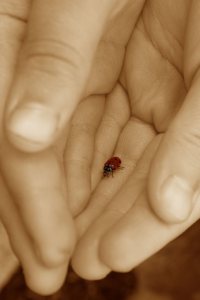
UPDATE:
Shortly after posting this I was taking some pictures of some of my mystery bulbs coming up and noticed the lady bug below, guess my garden can actually attract a few of them on its own.
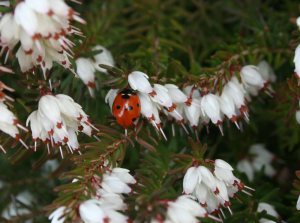
Tags: cheap, vegetables
